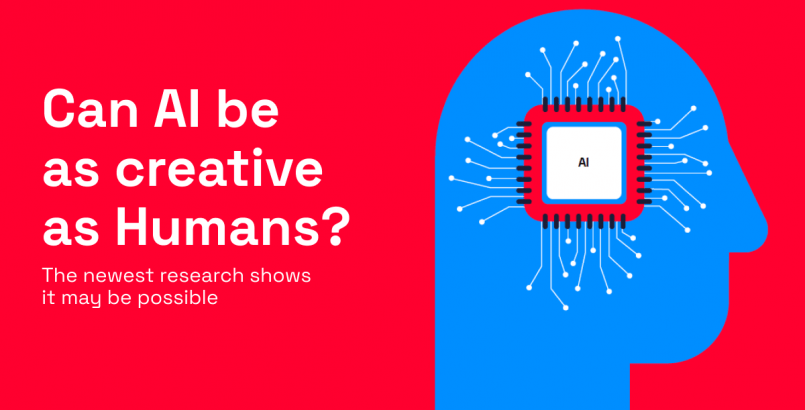The newest research shows it may be possible – source: The Future of Work Report 2024 “The World of Work AI-ed”
Creativity is an integral part of human life, extending to all areas of activity including business. Erik Guzik, an assistant clinical professor at the University of Montana’s College of Business , together with his team, have recently published a research paper suggesting that artificial intelligence can match the top one percent of human thinkers on a standard test of creativity. Below is an extract from an interview that Agnieszka Porębska, CEO of Talent Alpha had with the professor.
Agnieszka Porębska: We used to think that being creative was our domain, especially in the field of originality. Your study has proved that we may be wrong. Can you tell us more?
As part of my work, I teach entrepreneurship at the College of Business at the University of Montana. We’re constantly providing opportunities for our students to apply their creativity by giving them different tasks. We also started to give these tasks to ChatGPT. When ChatGPT-4 was introduced, we began to see ideas appear within it which excited us. These ideas, which were new, different, and unexpected could be applied to a problem. So we decided, as researchers, to give ChatGPT-4 a standard test of creativity just to see how it performed.
We applied the Torrance Tests of Creative Thinking, developed by E. Paul Torrance, which measures three different criteria of creativity. The first is just the number of ideas that are generated by the test taker. This is called fluency. The second measure, flexibility, is usually evaluated as the variety of ideas, different categories of ideas, and shifting in thinking processes. And then finally, the third measurement is originality. Originality is the novelty and uniqueness of the ideas generated by the test taker.
ChatGPT-4 landed in the top 1% for fluency, something which did not come as a surprise to us. We expected this. For flexibility, the eight tests achieved a top 7% result. Although it was not as good as we anticipated, I think what we will see as a key factor in the future is training for these AI models to think more flexibly. What was most surprising for us was originality. So ChatGPT tests all achieved the top percentile in original thinking relative to over 2,000 different human test takers.
AP: Does it mean that Chat GPT, AI, can be as creative and original as we are, or is this only one component of our creativity?
We try not to read too much into these results. There are various ways to understand creativity. Given my background in business and economics, I favor a definition of creativity which is focused on a product. This is just one aspect of creativity. You can also examine the creative process and the people involved, their behaviors and idiosyncrasies. Many creative people are unique in their thinking and actions, as observed in entrepreneurship. When it comes to AI, it suggests that at least one form of creativity, combining elements to create something new, is what GPT-4 and other AI models are able to simulate exceedingly well. AI excels at merging resources in novel ways due to its access to vast data that humans lack. In terms of diverse combinations, AI’s potential is endless, surpassing our individual capabilities because of its superior access to knowledge. However, I believe that for now, AI cannot replace us as creators. It is a tool that we can leverage in businesses to solve problems. That being said, I don’t believe AI is able to identify areas of its own inner curiosity and interest which I believe is a core element of creativity in general.
AP: What are the implications for business?
EG: AI is now not only capable of developing different ideas, but these ideas are becoming relevant and useful based on specific business cases. We’re just at the embryonic stages of what AI is capable of, in terms of generating new and unique ideas, which again is our definition of originality. We know every area of innovation, including the introduction of new products, processes, and solutions, depends on creative thinking. In terms of the impact it’s going to have on companies and regions and nations, then, it’s going to be significant. Here’s a tool that allows us to generate original ideas in a way we’ve never been able to generate before. If we look at the era of European Enlightenment, and look at industrialization in general across history and entire regions, we can again see that the essential element is creative thinking. Well, now we have a tool, Artificial Creative Intelligence, that is going to generate ideas in new and different ways which we’ve never had before. So this is going to be a significant breakthrough for business and industry, for regions and nations. I think this is very clear.
Read more about the future of work in the AI-ed world – download your free copy The Future of Work Report 2024 “The world of Work AI-ed”


Read also
The Human Cloud Ecosystem - Re-Shaping the Business World
Although cloud service was already on the rise before the pandemic, it wasn’t a necessity for many of the people in the industry. What has changed since then?
How Cloud Technology Became More Human
Working remotely has never been as popular as it is now, clearly demonstrating that its perks outweigh its disadvantages. Read more about it here.
VIDEO: Bridge Your Tech Talent Gap Webinar
On Wednesday March 3rd, Talent Alpha hosted our webinar Talent Intelligence in 2021: Understand, Unlock & Unleash Hidden Value in Your Organization